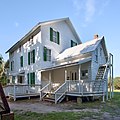
Blue Spring State Park is a state park located west of Orange City, Florida, in the United States. The park is a popular tourist destination; available activities include canoeing, SCUBA diving, kayaking, fishing, camping, hiking, wildlife watching, and swimming. The spring in the park is the largest on the St. Johns River. Due to its relatively warm temperature of 73 °F (23 °C), the spring attracts many Florida manatees during the winter. About 102 million US gallons (390,000 m3) of water flow out of Blue Spring into the St. Johns River every day.

The Dyckman House, now the Dyckman Farmhouse Museum, is the oldest remaining farmhouse on Manhattan island, a vestige of New York City's rural past. The Dutch Colonial-style farmhouse was built by William Dyckman, c.1785, and was originally part of over 250 acres (100 ha) of farmland owned by the family. It is now located in a small park at the corner of Broadway and 204th Street in Inwood, Manhattan.

The Cornwall Friends Meeting House is a historic meeting house located on a 5.4-acre (2.2 ha) parcel of land at the junction of Quaker Avenue and US 9W in Cornwall, New York, United States, near Cornwall-St. Luke's Hospital. It is both the oldest religious building in the town, and the first one built. In 1988 it was added to the National Register of Historic Places as a well-preserved, minimally-altered example of a late 18th-century Quaker meeting house.

The Colonel John Stuart House is a historic house at 104-106 Tradd Street in Charleston, South Carolina. Built in 1772, four years before the American Revolution, it is the city's oldest known example of a side-hall plan house. It is nationally significant as the home of Colonel John Stuart, who was the King's Superintendent of Indian Affairs in the South. He improved relations with the Five Civilized Tribes, especially the Cherokee Nation between the Seven Years' War and the American Revolutionary War. It was declared a National Historic Landmark in 1973.

The Foster–Payne House is a historic house at 25 Belmont Street in Pawtucket, Rhode Island. Built in 1878, the two-story multi-gabled house is distinguished by its clapboarded and exterior woodwork and opulent parlors in the interior. The property also has a matching carriagehouse with gable roof and cupola. The house was originally constructed and owned by Theodore Waters Foster, but it was sold to George W. Payne in 1882. The Foster–Payne House is architecturally significant as a well-designed and well-preserved late 19th century suburban residence. It was added to the National Register of Historic Places in 1983.
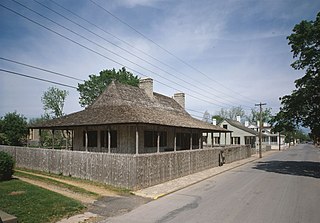
The Louis Bolduc House, also known as Maison Bolduc, is a historic house museum at 123 South Main Street in Ste. Geneviève, Missouri. It is an example of poteaux sur solle ("posts-on-sill") construction, and is located in the first European settlement in the present-day state of Missouri. The first historic structure in Ste. Genevieve to be authentically restored, the house is a prime example of the traditional French Colonial architecture of the early 18th century in North America and was designated in 1970 as a National Historic Landmark.

The Zane Grey Museum in Lackawaxen Township, Pennsylvania, United States, is a former residence of the author Zane Grey and is now maintained as a museum and operated by the National Park Service (NPS). It is located on the upper Delaware River and is on the National Register of Historic Places. It contains many photographs, artworks, books, furnishings, and other objects of interest associated with Grey and his family.
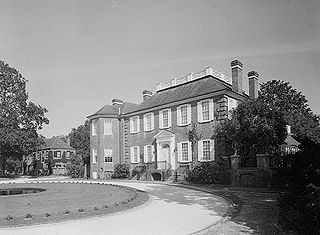
The Fenwick Hall, which is also known as Fenwick Castle, is a plantation house built about 1730 on Johns Island, South Carolina, across the Stono River from James Island and Charleston. It is located between River Road and Penneys Creek. It was named to the National Register of Historic Places on February 23, 1972.

The Charles Boyd Homestead is a group of three buildings that make up a pioneer ranch complex. It is located in Deschutes County north of Bend, Oregon, United States. The ranch buildings were constructed by Charles Boyd between 1905 and 1909. Today, the three surviving structures are the only ranch buildings that date back to the earliest period of settlement in the Bend area. The Boyd Homestead is listed as a historic district on the National Register of Historic Places.

St. Mary's Catholic Church is a parish church of the Diocese of Davenport. The church is located at the corner of St. Mary's and Washburn Streets in the town of Riverside, Iowa, United States. The entire parish complex forms an historic district listed on the National Register of Historic Places as St. Mary's Parish Church Buildings. The designation includes the church building, rectory, the former church, and former school building. The former convent, which was included in the historical designation, is no longer in existence.

The Ezekiel Phelps House is a historic house at 38 Holcomb Street in East Granby, Connecticut. Built in 1744, it is a fine example of Georgian architecture, associated with a prominent local family. It was listed on the National Register of Historic Places in 1982.

Craven Hall is a historic building located in Warminster Township, Pennsylvania, at the corner of Newtown Road and East Street Road, a five-lane arterial road which runs through the central commercial district. The house was originally built in 1780, with subsequent work in 1823 and a single story addition in the 20th century.

The George Tromley Jr. House is a historic building located in Le Claire, Iowa, United States. It has been listed on the National Register of Historic Places since 1979. The property is part of the Houses of Mississippi River Men Thematic Resource, which covers the homes of men from LeClaire who worked on the Mississippi River as riverboat captains, pilots, builders and owners.
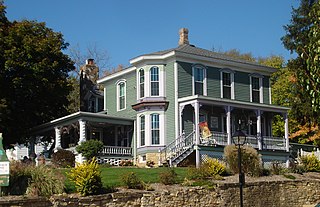
The McCaffrey House is an historic building located in Le Claire, Iowa, United States, and has been listed on the National Register of Historic Places since 1979. The property is part of the Houses of Mississippi River Men Thematic Resource, which covers the homes of men from LeClaire who worked on the Mississippi River as riverboat captains, pilots, builders and owners. It is also a contributing property in the Cody Road Historic District.
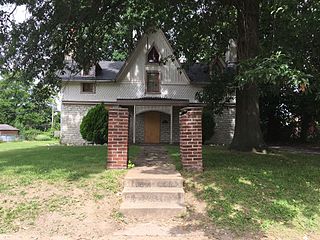
The Emmanuel DeHodiamont House is a house located at 951 Maple Place in the West End neighborhood of St. Louis, Missouri. The house was originally constructed about 1830 by local farmer Emmanuel DeHodiamont and was modified into the Gothic Revival style about 1875. It shares the status of being the oldest extant residence in the city of St. Louis with the Lewis Bissell House, and it is the oldest privately owned building in St. Louis. It was listed as a St. Louis Landmark in 1966 and listed on the National Register of Historic Places on December 4, 2002.

St. Anselm's Catholic Church, Rectory and Parish Hall in Anselmo, Nebraska are three separate structures that together form the St. Anselm parish complex. The church, also known as The Cathedral of the Sandhills, was built in 1928–1929, along with the rectory; the parish hall was constructed in 1905 and served as the original church building.

Jackson Park Town Site Addition Brick Row is a group of three historic houses and two frame garages located on the west side of the 300 block of South Third Street in Lander, Wyoming. Two of the homes were built in 1917, and the third in 1919. The properties were added to the National Register of Historic Places on February 27, 2003.

The Ivory Perry Homestead is a historic house at the corner of Valley and Dooe roads in Dublin, New Hampshire. Built about 1767 and enlarged about 1820, it retains many original features from its period of construction. It was built by Ivory Perry, one of Dublin's first white settlers. The house was listed on the National Register of Historic Places in 1983.

The Henry M. and Annie V. Trueheart House is a residence of historic significance located in the town of Fort Davis, the seat and largest town of Jeff Davis County in the U.S. state of Texas. The house was built in 1898 and, along with the surrounding property, was added to the National Register of Historic Places (NRHP) in 1996. The Trueheart House has also been distinguished as a Recorded Texas Historic Landmark (RTHL) since 1964.
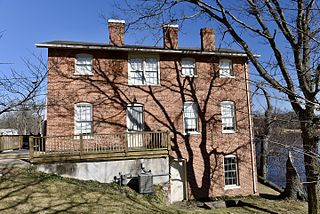
The Arthur Silliman House is a private house located at 116 South Main Street in Three Rivers, Michigan. It was listed on the National Register of Historic Places in 1979, and now houses The Historic Silliman Home and Blacksmith Shop.


